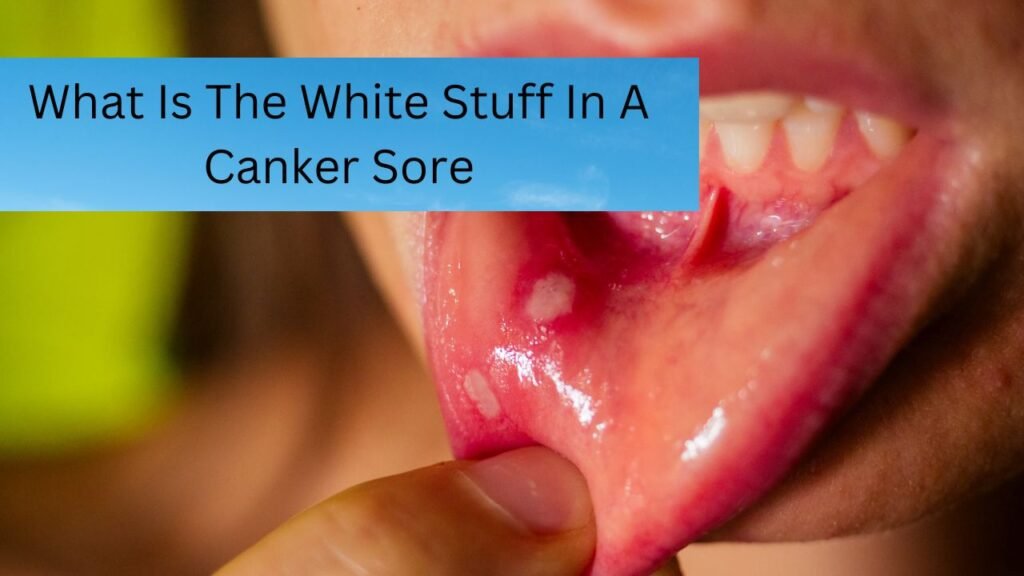Ever wondered about the mysterious white film covering your canker sore? If you’ve found yourself staring at a painful ulcer inside your mouth and noticed a white or grayish layer, you’re not alone. Understanding this white substance can help alleviate your concerns and guide you towards effective treatment and prevention. Let’s dive into what the white stuff in a canker sore really is and how you can manage it.
What is a Canker Sore?
Canker sores, also known as aphthous ulcers, are small, painful lesions that appear inside the mouth. They often present as:
- A red bump: Initially, canker sores start as tiny red bumps.
- A shallow ulcer: They develop into shallow, crater-like ulcers.
- A white or grayish center: The ulcer is typically surrounded by a red halo and covered by a white or grayish film.
Stages of a Canker Sore
- Initial Stage: The sore begins as a red, inflamed area.
- Development Stage: The area ulcerates, forming a shallow lesion with a white or gray center.
- Healing Stage: The sore gradually heals, and the white film fades.
What is the White Stuff in a Canker Sore?

The white substance in a canker sore is a normal part of the healing process. It is primarily composed of:
- Dead Cells: When the mucous membrane in your mouth is damaged, cells die and accumulate around the sore.
- Fibrin: This protein forms a protective layer over the ulcer. It plays a crucial role in blood clotting and tissue repair.
- Debris: Food particles and bacteria can contribute to the white appearance.
Understanding the Healing Process
When you develop a canker sore, your body’s natural response includes:
- White Blood Cells: These cells rush to the sore to fight off infection and facilitate healing, contributing to the white appearance.
- Fibrin Formation: Fibrin creates a temporary barrier to protect the sore and support new tissue growth.
Is the White Stuff Normal?
Yes, the white film is typically a normal part of the healing process. It indicates that your body is working to repair the damaged tissue.
However, if the white stuff is accompanied by other symptoms or doesn’t improve, it may be worth investigating further.
Common Causes of Canker Sores
Several factors can trigger canker sores, leading to the development of the white film:
- Stress: Emotional or physical stress can disrupt the mucous membranes in your mouth, leading to sores.
- Dietary Deficiencies: Lack of essential nutrients, such as vitamin B12, folic acid, and iron, can increase the likelihood of developing canker sores.
- Oral Injury: Biting your cheek or tongue, or irritation from dental appliances, can cause sores.
- Hormonal Changes: Hormonal fluctuations, especially during menstruation, may play a role.
- Food Sensitivities: Spicy or acidic foods can irritate the mouth’s mucous membrane.
Less commonly, medications and underlying health conditions may also trigger canker sores.
Types of Canker Sores
Understanding the different types of canker sores can help you identify their appearance and severity:
- Minor Canker Sores: These are small, shallow ulcers that typically heal within one to two weeks. The white film is usually localized and less extensive.
- Major Canker Sores: Larger and deeper than minor sores, they can be more painful and may take longer to heal. The white film may be more extensive and persistent.
- Herpetiform Canker Sores: These occur in clusters and can be more difficult to distinguish due to their size and number. The white film may appear more spread out.
When to Worry
While most canker sores are harmless, there are signs that may indicate a need for medical attention:
- Persistent Sores: If a sore doesn’t heal within two weeks or if new sores continue to appear.
- Severe Pain: Intense pain that doesn’t improve with over-the-counter treatments.
- Systemic Symptoms: If you experience fever, swollen lymph nodes, or difficulty swallowing, consult a healthcare professional.
Most canker sores resolve on their own, but persistent or severe cases should be evaluated by a dentist or doctor.
Treatment and Prevention
Effective Treatments
- Topical Medications: Over-the-counter products like Orajel or Anbesol can provide pain relief and protect the sore.
- Mouth Rinses: Antiseptic or numbing mouthwashes can help reduce discomfort.
- Pain Relievers: Ibuprofen or acetaminophen can alleviate pain and inflammation.
Home Remedies
- Saltwater Rinses: Gargling with a saltwater solution can soothe the sore and reduce inflammation.
- Baking Soda Paste: A paste made of baking soda and water can neutralize acids and promote healing.
- Honey: Its natural antibacterial properties can reduce pain and support recovery.
Alternative Treatments
- Aloe Vera: Known for its soothing and healing properties.
- Licorice Root Extract: May help reduce pain and inflammation, though more research is needed.
Always consult a healthcare professional before trying alternative treatments to ensure they’re appropriate for your condition.
Prevention Tips
- Maintain Good Oral Hygiene: Brush and floss regularly to prevent infections.
- Manage Stress: Practice relaxation techniques such as meditation or deep breathing.
- Follow a Balanced Diet: Ensure adequate intake of essential vitamins and minerals.
- Avoid Irritants: Limit the consumption of spicy or acidic foods that can trigger sores.
Conclusion
In most cases, the white stuff in a canker sore is a normal and temporary part of the healing process. By understanding its role and managing the underlying triggers, you can ease your discomfort and promote faster healing. For persistent or severe symptoms, seeking professional advice is crucial.
If you have concerns about your symptoms or need personalized advice, consult your dentist or healthcare provider.